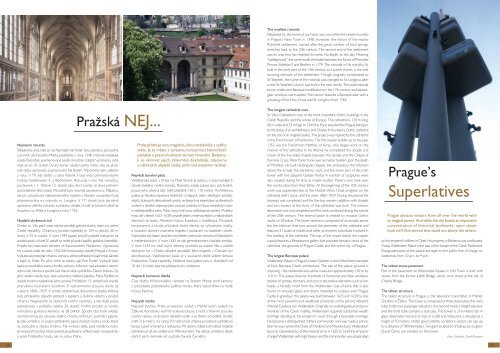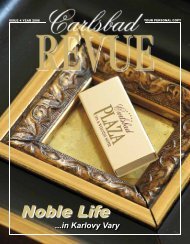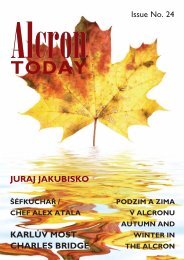stáhnout ve formátu PDF - My Companion, sro
stáhnout ve formátu PDF - My Companion, sro
stáhnout ve formátu PDF - My Companion, sro
Create successful ePaper yourself
Turn your PDF publications into a flip-book with our unique Google optimized e-Paper software.
The smallest rotunda<br />
·tûpánská St., the home of our hotel, was one of the first streets founded<br />
in Prague’s New Town in 1348. Howe<strong>ve</strong>r, the history of the nearby<br />
Rybníãek settlement, named after the great number of local springs,<br />
stretches back to the 10th century. The second end of the settlement<br />
was an area that has retained its name, Na Boji‰ti, to this day. Meaning<br />
“battleground,” the name recalls the battle between the forces of Pfiemyslid<br />
Princes Sobûslav II and Bedfiich in 1179. The rotunda in Na rybníãku St,<br />
built in the early part of the 12th century as a parish church, is the sole<br />
surviving remnant of this settlement. Though originally consecrated to<br />
St. Stephen, the name of the rotunda was changed to St. Longinus after<br />
a new St. Stephen’s church was built in the near vicinity. The small rotunda<br />
tower underwent Baroque modifications in the 17th century and stainedglass<br />
windows were added. The interior features a Baroque altar with a<br />
grouping of the Holy Cross and St. Longinus from 1762.<br />
PraÏská NEJ...<br />
Nejmen‰í rotunda<br />
·tûpánská ulice, kde se nachází také nበhotel, byla zaloÏena jako jedna<br />
z prvních ulic Nového Mûsta praÏského v roce 1348. Historie nedaleké<br />
osady Rybníãek, pojmenované podle mnoÏství zdej‰ích pramenÛ, sahá<br />
v‰ak aÏ do 10. století. Druh˘ konec osady tvofiilo místo, kde se aÏ do<br />
na‰í doby zachovalo pojmenování Na Boji‰ti. Pfiipomíná nám události<br />
z roku 1179, kdy do‰lo u obce Rybník k boji mezi pfiemyslovsk˘mi<br />
kníÏaty Sobûsla<strong>ve</strong>m II. a Bedfiichem. Rotunda v ulici Na rybníãku,<br />
posta<strong>ve</strong>ná v 1. tfietinû 12. století jako farní kostel, je dnes jedin˘m<br />
pozÛstatkem této osady. PÛvodnû byla rotunda zasvûcena sv. ·tûpánu,<br />
ale po vybudování stejnojmenného kostela v tûsném sousedství byla<br />
pfiejmenována na rotundu sv. Longina. V 17. století byla baroknû<br />
upra<strong>ve</strong>na vûÏiãka rotundy a pfiidány vitráÏe. Uvnitfi je barokní oltáfi se<br />
skupinou sv. KfiíÏe a Longina z roku 1762.<br />
Nejdel‰í chrámová loì<br />
Chrám sv. Víta patfií mezi nejv˘znamnûj‰í gotické stavby nejen na území<br />
âeské republiky. Chrámov˘ prostor katedrály je 124 m dlouh˘, 60 m<br />
‰irok˘ a 33 m vysok˘. V roce 1344 papeÏ pov˘‰il praÏské biskupství na<br />
arcibiskupství, a Karel IV. zaloÏil na místû pÛvodní baziliky gotickou katedrálu.<br />
Projekt byl inspirován dómem <strong>ve</strong> francouzském Narbonnu. Vypracoval<br />
ho a stavbu také do roku 1352 fiídil francouzsk˘ stavitel Matyበz Arrasu.<br />
Vybudoval presbytáfi chrámu, ochoz a vûnec pûtibok˘ch kaplí mezi sakristií<br />
a kaplí sv. KfiíÏe. Po jeho smrti se stavby ujal Petr Parléfi. Vystavûl dal‰í<br />
kaple pravoúhlého tvaru, chodbu ochozu, triforium nad arkádami, okenní<br />
stûnu lodi, klenbu a spodní ãást hlavní vûÏe s pfiilehlou Zlatou bránou. Za<br />
jeho <strong>ve</strong>dení stavby byly také vytvofieny nûkteré plastiky. Petra Parléfie <strong>ve</strong><br />
stavbû chrámu následovali jeho synové. Poãátkem 15. století byla stavba<br />
pfieru‰ena husitsk˘mi boufiemi. K v˘znamnému posunu do‰lo aÏ<br />
v letech 1860–1929. V tomto období byla dokonãena stavba kfiíÏové<br />
lodi, pfiistavûno západní pûtilodí s kaplemi a dvûma vûÏemi v prÛãelí<br />
chrámu. Nepodafiilo se dokonãit vnitfiní v˘zdobu, a tak dal‰í práce<br />
pokraãovaly v prÛbûhu celého 20. století. Vnitfiní prostor je tvofien<br />
mohutnou gotickou klenbou na 28 pilífiích. Spodní ãást tvofií arkády,<br />
nad kter˘mi je po obvodu celého chrámu triforium, portrétní galerie.<br />
Je zde umístûno 21 poprsí pfiíslu‰níkÛ panovnick˘ch rodin a osob, které<br />
se zaslouÏily o stavbu chrámu. Na vrcholu vûÏe, pod mûdûnou bání,<br />
je renesanãní ochoz, kter˘ poskytuje jedineãn˘ v˘hled nejen na katedrálu<br />
a areál PraÏského hradu, ale na celou Prahu.<br />
Praha pfiitahuje svou magickou silou náv‰tûvníky z celého<br />
svûta. Je to mûsto s v˘raznou koncentrací historick˘ch<br />
památek a pozoruhodností na metr ãt<strong>ve</strong>reãní. Budemeli<br />
se vûnovat jejich zkoumání dÛkladnûji, objevíme<br />
u nûkter˘ch objektÛ znaky, jimiÏ nad ostatními vynikají.<br />
Nejvût‰í barokní palác<br />
Vald‰tejnsk˘ palác v Praze na Malé Stranû je jednou z nejv˘raznûj‰ích<br />
sta<strong>ve</strong>b ãeského raného baroka. Rozmûry areálu paláce jsou úctyhodné,<br />
pouze jeho obytná ãást mûfií pfiibliÏnû 150 x 110 metrÛ. Architektura<br />
paláce je ãlenûna stovkami funkãních ãi slep˘ch oken, desítkami portálÛ,<br />
vik˘fiÛ, ‰tukov˘ch dekorativních prvkÛ, <strong>ve</strong> kter˘ch se stejnû jako na dfievûn˘ch<br />
vratech a d<strong>ve</strong>fiích objevuje jako souãást v˘zdoby lví hlava, heraldick˘ motiv<br />
z vald‰tejnského erbu. Palác, kter˘ mûl svou <strong>ve</strong>lkolepostí zastínit i PraÏsk˘<br />
hrad, dal v letech 1623–1630 vystavût jeden z nejmocnûj‰ích a nejbohat‰ích<br />
‰lechticÛ té doby, Albrecht Václav Eusebius z Vald‰tejna. PÛvodnû<br />
nev˘znamn˘ a chud˘ pfiíslu‰ník ãeské ‰lechty se v˘hodn˘mi sÀatky<br />
a koupûmi domohl znaãného majetku i posta<strong>ve</strong>ní na císafiském dvofie.<br />
VojevÛdce byl ãasem pov˘‰en na kníÏete, jmenován vévodou fr˘dlantsk˘m<br />
a meklenbursk˘m. V roce 1625 se stal generalissimem císafiské armády.<br />
V roce 1634 ho císafi sv˘mi dekrety prohlásil za zrádce fií‰e a císafi‰tí<br />
dÛstojníci ho v Chebu úkladnû zavraÏdili. Jeho majetek v âechách byl<br />
zkonfiskován. Vald‰tejnsk˘ palác je v souãasné dobû sídlem Senátu<br />
Parlamentu âeské republiky. Nûkteré ãásti paláce jsou o víkendech od<br />
10 do 16 hodin zdarma pfiístupné pro <strong>ve</strong>fiejnost.<br />
Nejstar‰í kamenná dlaÏba<br />
âást dlaÏby KfiiÏovnického námûstí na Starém Mûstû tvofií kameny<br />
z pozÛstatkÛ pobofieného Juditina mostu, kter˘ stával dfií<strong>ve</strong> na místû<br />
mostu Karlova.<br />
Nejvy‰‰í stavba<br />
Nejvy‰‰í stavbou Prahy je televizní vysílaã v Mahlerov˘ch sadech na<br />
ÎiÏkovû. Konstrukci tvofií tfii ocelové tubusy, z nichÏ v hlavním jsou dva<br />
osobní v˘tahy, <strong>ve</strong> druhém nákladní v˘tah a <strong>ve</strong> tfietím schodi‰tû. Vysílaã<br />
mûfií 216 metrÛ. Ve v˘‰ce 93 metrÛ byla zfiízena prosklená vyhlídková<br />
terasa a pod ní kavárna s restaurací. Pfii dobré viditelnosti odtud mÛÏete<br />
dohlédnout aÏ do vzdálenosti 100 kilometrÛ. Na vûÏi je umístûno deset<br />
obfiích soch miminek od sochafie Davida âerného.<br />
The longest cathedral na<strong>ve</strong><br />
St. Vitus Cathedral is one of the most important Gothic buildings in the<br />
Czech Republic and the whole of Europe. The cathedral is 124 m long,<br />
60 m wide and 33 m high. In 1344 the Pope elevated the Prague bishopric<br />
to the status of an archbishopric and Charles IV founded a Gothic cathedral<br />
on the site of an original basilica. The project was inspired by the cathedral<br />
in the French town of Narbonne. The first master builder up to the year<br />
1352 was the Frenchman Matthias of Arras, who began work on the<br />
chancel of the cathedral. In his lifetime he completed the arcade and<br />
crown of the fi<strong>ve</strong>-sided chapels between the sacristy and the Chapel of<br />
the Holy Cross. Peter Parler took o<strong>ve</strong>r as master builder upon the death<br />
of Matthias. He built rectangular chapels, the ambulatory, the triforium<br />
abo<strong>ve</strong> the arcade, the clerestory, vault, and the lower part of the main<br />
tower with the adjacent Golden Portal. A number of sculptures were<br />
also created during his time as master builder. Parler’s sons took o<strong>ve</strong>r<br />
the construction from their father. At the beginning of the 15th century<br />
work was suspended due to the Hussite Wars. Great progress on the<br />
cathedral didn’t occur until the years 1860–1929. During this period the<br />
transept was completed and the fi<strong>ve</strong>-bay western addition with chapels<br />
and two towers at the front of the cathedral was built. The interior<br />
decoration was not completed and this work continued during the course<br />
of the 20th century. The internal space is created by massi<strong>ve</strong> Gothic<br />
vaults on 28 pillars. The lower section is composed of an arcade; abo<strong>ve</strong><br />
this the triforium that runs around the perimeter of the cathedral and<br />
features 21 busts of nobles and other prominent individuals invol<strong>ve</strong>d in<br />
the building of the cathedral. The top of the tower below the copper<br />
cupola features a Renaissance gallery that provides fantastic views of the<br />
cathedral, the grounds of Prague Castle, and the entire city of Prague.<br />
The largest Baroque palace<br />
Wallenstein Palace in Prague’s Lesser Quarter is one of the finest examples<br />
of Early Baroque Czech architecture. The size of the palace grounds is<br />
imposing - the residential area alone measures approximately 150 m by<br />
110 m. The palace features hundreds of functional and false windows,<br />
dozens of portals, dormers, and stucco decorati<strong>ve</strong> elements such as lion<br />
heads, a heraldic motif from the Wallenstein coat of arms that is also<br />
found on wooden gates and doors. Intended to surpass e<strong>ve</strong>n Prague<br />
Castle in grandeur, the palace was built between 1623 and 1630 by one<br />
of the most powerful and wealthiest aristocrats of the period, Albrecht<br />
Wenzel Eusebius von Wallenstein. Originally an undistinguished and poor<br />
member of the Czech nobility, Wallenstein acquired substantial wealth<br />
and high standing at the emperor’s court through a favorable marriage.<br />
He became a distinguished military commander and was made a prince;<br />
later he was named the Duke of Friedland and Mecklenburg. Wallenstein<br />
became Generalissimo of the imperial army in 1625. In 1634 the emperor<br />
charged Wallenstein with high treason and the commander was assassinated<br />
Prague’s<br />
Superlati<strong>ve</strong>s<br />
Prague attracts visitors from all o<strong>ve</strong>r the world with<br />
its magical power. And while the city boasts an impressi<strong>ve</strong><br />
concentration of historical landmarks, upon closer<br />
look we’ll find se<strong>ve</strong>ral that stand out abo<strong>ve</strong> the others.<br />
by the emperor’s officers in Cheb. His property in Bohemia was confiscated.<br />
Today Wallenstein Palace is the seat of the Senate of the Czech Parliament.<br />
Designated parts of the palace are open to the public free of charge on<br />
weekends from 10 a.m. to 4 p.m.<br />
The oldest stone pa<strong>ve</strong>ment<br />
Part of the pa<strong>ve</strong>ment on KfiiÏovnické Square in Old Town is built with<br />
stones from the former Judith Bridge, which once stood at the site of<br />
Charles Bridge.<br />
The tallest structure<br />
The tallest structure in Prague is the television transmitter in Mahler<br />
Gardens in ÎiÏkov. The tower is composed of three steel tubes; the main<br />
tube holds two passenger elevators, the second holds a freight elevator<br />
and the third tube contains a staircase. The tower is 216 meters tall. A<br />
glass observation terrace on top of a café and restaurant is situated at a<br />
height of 93 meters. Under good visibility conditions visitors can see up<br />
to a distance of 100 kilometers. Ten giant sculptures of babies, by sculptor<br />
David âern˘, are installed on the tower.<br />
foto / photos: CzechTourism<br />
11 24<br />
25






